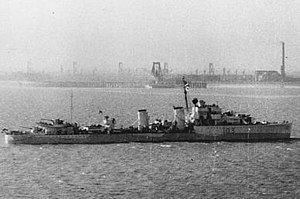Name HMS Icarus Commissioned 1 May 1937 Launched 26 November 1936 Draft 3.81 m | Laid down 9 March 1936 Decommissioned 29 August 1946 Construction started 9 March 1936 Length 98 m Builder John Brown & Company | |
 | ||
Motto Bene est tentare("It is as well to try") Operations Norwegian Campaign, Battle of Dunkirk | ||
HMS Icarus was one of nine I-class destroyers built for the Royal Navy during the 1930s.
Contents
Description
The I-class ships were improved versions of the preceding H-class. They displaced 1,370 long tons (1,390 t) at standard load and 1,888 long tons (1,918 t) at deep load. The ships had an overall length of 323 feet (98.5 m), a beam of 33 feet (10.1 m) and a draught of 12 feet 6 inches (3.8 m). They were powered by two Parsons geared steam turbines, each driving one propeller shaft, using steam provided by three Admiralty three-drum boilers. The turbines developed a total of 34,000 shaft horsepower (25,000 kW) and gave a maximum speed of 35.5 knots (65.7 km/h; 40.9 mph). Icarus carried a maximum of 455 long tons (462 t) of fuel oil that gave her a range of 5,500 nautical miles (10,200 km; 6,300 mi) at 15 knots (28 km/h; 17 mph). The ships' complement was 145 officers and ratings.
The ships mounted four 4.7-inch (120 mm) Mark IX guns in single mounts. For anti-aircraft (AA) defence, they had two quadruple Mark I mounts for the 0.5 inch Vickers Mark III machine gun. The I class was fitted with two above-water quintuple torpedo tube mounts for 21-inch (533 mm) torpedoes. One depth charge rack and two throwers were fitted; 16 depth charges were originally carried, but this increased to 35 shortly after the war began.
Construction and career
On 29 November 1939, Icarus sighted the German submarine U-35 between the Shetland Islands and Bergen (Norway), but was unable to launch an effective attack because her ASDIC (sonar) was out of commission. Fellow destroyers Kingston and Kashmir were called to the scene, and Icarus departed. Kingston was able to launch a successful depth charge attack, forcing the U-boat to surface and scuttle itself.
Icarus participated in the Norwegian campaign in 1940, first capturing the 8,514 ton German supply ship Alster (brought to the United Kingdom and renamed Empire Endurance) on 11 April and then taking part in the Second Battle of Narvik on 13 April 1940.
In early May 1941, the British Admiralty was on the alert that the Bismarck might attempt to break out into the North Atlantic; so Icarus was ordered to Scapa Flow for possible deployment against the Germans. On 22 May, just after midnight, Icarus sailed along with the destroyers Achates, Antelope, Anthony, Echo, and Electra, escorting the battlecruiser Hood and the battleship Prince of Wales to cover the northern approaches. The intention was that the force would refuel in Hvalfjord, Iceland, and then sail again to watch the Denmark Strait.
On the evening of 23 May, the weather deteriorated. At 20:55 hrs., Admiral Lancelot Holland aboard Hood signalled the destroyers "If you are unable to maintain this speed I will have to go on without you. You should follow at your best speed." At 02:15 on the morning of 24 May, the destroyers were ordered to spread out at 15 miles (24 km) intervals to search to the north. At about 05:35, the German forces were sighted by Hood, and shortly after, the Germans sighted the British ships. Firing commenced at 05:52. At 06:01, Hood took a 38 centimetres (15 in) shell from Bismarck in the after magazine, which caused a massive explosion, sinking the ship within 2 minutes. Electra and the other destroyers were about 60 miles (97 km) away at the time.
Upon hearing that Hood had sunk, Electra raced to the area, arriving about 2 hours after Hood went down. They were expecting to find many survivors, and rigged scrambling nets and heaving lines, and placed life belts on the deck where they could be quickly thrown in. From the 94 officers and 1,321 ratings aboard Hood, just three survivors were found. Electra rescued them, and continued searching. Shortly thereafter, Icarus and Anthony joined in the search, and the three ships searched the area for more survivors. No more were found, only driftwood, debris, and a desk drawer filled with documents. After several hours searching, they left the area.
She participated in Operation Pedestal, escorting a convoy to Malta in August 1942.
Icarus was involved in many important events of World War II, Dunkirk, Spitzbergen, and numerous Atlantic and Russian convoys.
Icarus sank four German U-boats:
A long-time captain of Icarus, Colin Maud, was the Juno beach master at the D-day landings; in the film 'The Longest Day' he was played by Kenneth More, complete with bulldog.
Lieutenant-Commander John Simon Kerans, famous for his part in sailing HMS Amethyst, down the Yangtze River, a feat made famous in the film Yangtse Incident, also served in Icarus as "number one".
Icarus was paid off on 29 August 1946, handed over to the British Iron and Steel Corporation on 29 October 1946 and broken up at Troon in Scotland.
